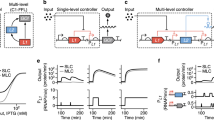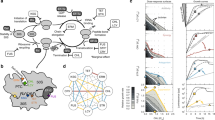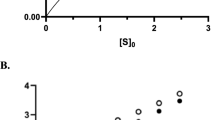Abstract
ACCORDING to recent theories, the induction of enzyme synthesis occurs as a result of the displacement from an enzyme-forming system of a natural repressor1. For example, the synthesis of alkaline phosphatase by E. coli is normally repressed by inorganic phosphate2. De-repression occurs when there is only a small amount of inorganic phosphate in the medium. The repressor theory is in good agreement with most of the observations which have been made on enzyme-inducing systems. The inducer need not be a substrate for the enzyme which is formed, nor need it serve as a template for the formation of new enzymes1.
This is a preview of subscription content, access via your institution
Access options
Subscribe to this journal
Receive 51 print issues and online access
$199.00 per year
only $3.90 per issue
Buy this article
- Purchase on Springer Link
- Instant access to full article PDF
Prices may be subject to local taxes which are calculated during checkout
Similar content being viewed by others
References
Pardee, A. B., Jacob, F., and Monod, J., J. Molec. Biol., 1, 165 (1959).
Torriani, A., Biochim. Biophys. Acta, 38, 460 (1960).
Knox, W. E., in “Cellular Metabolism and Infections”, edit. by Racker, E., 45 (Academic Press, Inc., New York, 1954). Dietrich, L. S., J. Biol. Chem., 211, 79 (1954). Fitch, W. M., and Chaikoff, I. L., ibid., 235, 554 (1960).
Brodie, B. B., Maickle, R. P., and Jondorf, W. R., Fed. Proc., 17, 753 (1957).
Conney, A. H., Miller, E. C., and Miller, J. A., J. Biol. Chem., 228, 753 (1957).
Cramer, J. W., Miller, J. A., and Miller, E. C., J. Biol. Chem., 235, 250 (1960).
Conney, A. H., Miller, E. C., and Miller, J. A., Cancer Res., 16, 450 (1956).
Conney, A. H., and Burns, J. J., Nature, 184, 363 (1959).
Burns, J. J., Evans, C., and Trousof, N., J. Biol. Chem., 227, 785 (1957).
Longenecker, H. E., Fricke, H. H., and King, C. G., J. Biol. Chem., 135, 497 (1940).
Glenn, E. M., Lyster, S. C., Bowman, B. J., and Richardson, S. L., Endocrinol., 64, 419 (1959).
Axelrod, J., J. Pharmacol. Exp. Therap., 117, 322 (1956).
Axelrod, J., Science, 124, 263 (1956).
Cochin, J., and Axelrod, J., J. Pharmacol. Exp. Therap., 125, 105 (1959).
Author information
Authors and Affiliations
Rights and permissions
About this article
Cite this article
SHUSTER, L. Repression and De-repression of Enzyme Synthesis as a Possible Explanation of some Aspects of Drug Action. Nature 189, 314–315 (1961). https://doi.org/10.1038/189314a0
Issue Date:
DOI: https://doi.org/10.1038/189314a0
This article is cited by
-
Are astroglial cells involved in morphine tolerance?
Neurochemical Research (1988)
-
Fluctuations of acetylcholinesterase in the mouse spinal cord and in vivo sodium effect during the development of morphine tolerance, dependence, and withdrawal
Neurochemical Research (1986)
-
Neurotransmitter uptake in various brain regions of chronically morphinized rats
Neurochemical Research (1986)
-
Selective development of tolerance without dependence in multiple opiate receptors of mouse vas deferens
Nature (1980)
Comments
By submitting a comment you agree to abide by our Terms and Community Guidelines. If you find something abusive or that does not comply with our terms or guidelines please flag it as inappropriate.



